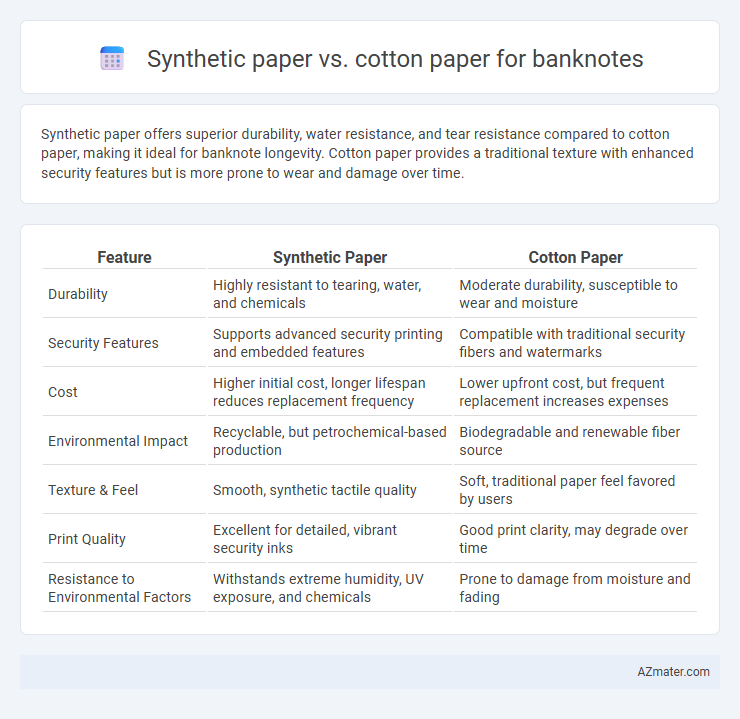Synthetic paper offers superior durability, water resistance, and tear resistance compared to cotton paper, making it ideal for banknote longevity. Cotton paper provides a traditional texture with enhanced security features but is more prone to wear and damage over time.
Table of Comparison
| Feature | Synthetic Paper | Cotton Paper |
|---|---|---|
| Durability | Highly resistant to tearing, water, and chemicals | Moderate durability, susceptible to wear and moisture |
| Security Features | Supports advanced security printing and embedded features | Compatible with traditional security fibers and watermarks |
| Cost | Higher initial cost, longer lifespan reduces replacement frequency | Lower upfront cost, but frequent replacement increases expenses |
| Environmental Impact | Recyclable, but petrochemical-based production | Biodegradable and renewable fiber source |
| Texture & Feel | Smooth, synthetic tactile quality | Soft, traditional paper feel favored by users |
| Print Quality | Excellent for detailed, vibrant security inks | Good print clarity, may degrade over time |
| Resistance to Environmental Factors | Withstands extreme humidity, UV exposure, and chemicals | Prone to damage from moisture and fading |
Introduction to Banknote Materials
Banknotes utilize materials designed for durability and security, with synthetic paper and cotton paper being the primary substrates. Synthetic paper, composed of polymer blends, offers enhanced resistance to water, tearing, and counterfeiting compared to traditional cotton paper, which is made from 100% cotton fibers providing a unique tactile feel and improved strength over regular paper. The choice between these materials impacts the longevity, security features, and overall performance of banknotes in circulation.
What is Synthetic Paper?
Synthetic paper is a durable material made primarily from polypropylene or polyethylene, offering superior resistance to water, tearing, and chemicals compared to traditional cotton paper. Unlike cotton paper, which consists of natural fibers, synthetic paper provides enhanced longevity and security features essential for banknotes. Its smooth, printable surface supports high-quality ink adhesion, making it ideal for anti-counterfeiting measures in currency production.
What is Cotton Paper?
Cotton paper, commonly used in banknotes, is primarily composed of cotton fibers, making it highly durable, tactile, and resistant to wear and tear compared to regular wood-pulp paper. Its fibrous structure allows for advanced security features like watermarks and security threads, essential for anti-counterfeiting measures. Cotton paper's ability to absorb ink vividly and withstand repeated handling ensures longevity and maintains the banknote's integrity in circulation.
Durability: Synthetic vs Cotton Paper
Synthetic paper used in banknotes offers superior durability compared to cotton paper, with enhanced resistance to water, tearing, and chemical damage. Cotton paper banknotes, while traditional and widely used, tend to wear out faster due to their fibrous nature, leading to more frequent replacements. The extended lifespan of synthetic banknotes reduces maintenance costs and improves currency circulation efficiency.
Security Features and Counterfeit Resistance
Synthetic paper used in banknotes incorporates advanced security features such as embedded polymer threads, transparent windows, and microprinted patterns that enhance counterfeit resistance beyond traditional cotton paper. Cotton paper, while durable and favored for its tactile feel, lacks integrated polymer elements, making it more susceptible to sophisticated forging techniques. The combination of synthetic substrates with high-tech security elements significantly elevates the difficulty of replication and strengthens overall currency authentication.
Environmental Impact and Sustainability
Synthetic paper used for banknotes offers superior durability and resistance to water and chemicals, reducing the frequency of replacements and thus lowering overall resource consumption. Cotton paper, traditionally favored for its natural fibers, is biodegradable and recyclable but requires significant amounts of water and energy during production, contributing to a larger carbon footprint. Sustainable banknote production increasingly favors synthetic materials that balance longevity with environmental impact, supporting eco-friendly currency lifecycles through reduced waste and resource use.
Cost Efficiency and Production
Synthetic paper offers superior cost efficiency for banknote production due to its durability, resistance to water, and extended lifespan, reducing the need for frequent replacements. Cotton paper, traditionally used in banknotes, has higher production costs associated with raw material sourcing and lower durability, leading to increased maintenance expenses. The scalability of synthetic paper manufacturing allows for consistent quality control and faster production cycles compared to the more labor-intensive cotton paper process.
Printing Quality and Design Flexibility
Synthetic paper offers superior printing quality for banknotes due to its smooth, consistent surface that enhances ink adherence and sharpness, resulting in clear, vibrant security features. Cotton paper, traditionally used in banknotes, provides excellent durability and a unique texture but can limit design flexibility due to its fibrous structure and variability. The synthetic material allows for more intricate designs and advanced security elements, improving anti-counterfeiting measures compared to the more absorbent and less uniform cotton substrate.
User Experience: Feel and Handling
Synthetic paper offers a smooth, durable, and water-resistant texture that enhances the tactile experience of banknotes, providing crisp handling without easily tearing or creasing. Cotton paper, prized for its fibrous and soft feel, delivers a traditional, secure grip that users associate with authenticity and high-quality currency. The choice between synthetic and cotton papers significantly influences the user's perception of durability and legitimacy during everyday transactions.
Global Trends in Banknote Materials
Global trends in banknote materials reveal a significant shift towards synthetic paper due to its enhanced durability, water resistance, and counterfeit prevention features compared to traditional cotton paper. Central banks worldwide are increasingly adopting polymer substrates, with countries like Australia, Canada, and the UK leading the transition to synthetic banknotes to reduce lifecycle costs and improve security. Despite cotton paper's historical prevalence, synthetic alternatives dominate the market driven by advancements in polymer technology and the demand for sustainable, long-lasting currency solutions.

Infographic: Synthetic paper vs Cotton paper for Banknote
 azmater.com
azmater.com